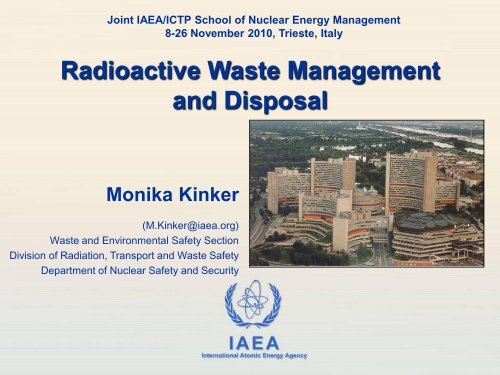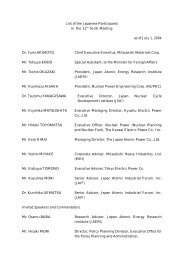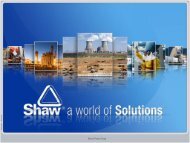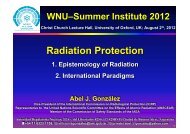Radioactive Waste Management and Disposal
Radioactive Waste Management and Disposal
Radioactive Waste Management and Disposal
Create successful ePaper yourself
Turn your PDF publications into a flip-book with our unique Google optimized e-Paper software.
Joint IAEA/ICTP School of Nuclear Energy <strong>Management</strong><br />
8-26 November 2010, Trieste, Italy<br />
<strong>Radioactive</strong> <strong>Waste</strong> <strong>Management</strong><br />
<strong>and</strong> <strong>Disposal</strong><br />
Monika Kinker<br />
(M.Kinker@iaea.org)<br />
<strong>Waste</strong> <strong>and</strong> Environmental Safety Section<br />
Division of Radiation, Transport <strong>and</strong> <strong>Waste</strong> Safety<br />
Department of Nuclear Safety <strong>and</strong> Security<br />
IAEA<br />
International Atomic Energy Agency
<strong>Radioactive</strong> <strong>Waste</strong> <strong>and</strong> Spent Fuel<br />
<strong>Management</strong> Unit<br />
• Support to Member States in establishing proper<br />
safety framework (regime) for management of<br />
spent fuel <strong>and</strong> radioactive waste:<br />
• Joint Convention on the Safety of Spent Fuel <strong>and</strong><br />
<strong>Radioactive</strong> <strong>Waste</strong> <strong>Management</strong><br />
• Development of Safety St<strong>and</strong>ards<br />
• Provisions for use <strong>and</strong> application of Safety St<strong>and</strong>ards<br />
IAEA 2
• IAEA Statute:<br />
• Develop safety<br />
st<strong>and</strong>ards<br />
• Provisions for<br />
their application<br />
<strong>and</strong> guidance on<br />
good practices<br />
IAEA Activities<br />
Nuclear safety<br />
Radiation Safety<br />
<strong>Waste</strong> Safety<br />
Transport Safety<br />
Peer reviews<br />
Technical cooperation<br />
Research <strong>and</strong><br />
development<br />
Training<br />
Exchange of<br />
information (networks)<br />
IAEA 3
International Safety St<strong>and</strong>ards<br />
• IAEA develops safety st<strong>and</strong>ards related to<br />
management of RAW<br />
• <strong>Management</strong> of all types of radioactive waste<br />
• Release of sites <strong>and</strong> materials from regulatory control<br />
• Safety assessment<br />
• <strong>Management</strong> of contaminated scrap metal<br />
• Safety St<strong>and</strong>ards reflect international consensus<br />
on the safety level needed to protect people <strong>and</strong><br />
the environment from the ionizing radiation<br />
• IAEA Safety St<strong>and</strong>ards are revised on regular<br />
basis to incorporate new knowledge, experiences<br />
<strong>and</strong> good practices<br />
IAEA 4
Hierarchy of Safety St<strong>and</strong>ards…evolving<br />
IAEA 5
2005 2006<br />
Small<br />
Generators<br />
Storage<br />
Safety St<strong>and</strong>ards: Predisposal<br />
BSS<br />
DS 379<br />
Storage of<br />
SNF<br />
DS 371<br />
2009<br />
FCFs HLW<br />
DS 447<br />
2010<br />
L/ILW<br />
Reactors<br />
DS 448<br />
2010<br />
Classification<br />
2008<br />
<strong>Management</strong><br />
System<br />
Safety Case &<br />
Safety<br />
Assessment<br />
DS 284<br />
IAEA 6
Near Surface<br />
<strong>Disposal</strong><br />
DS 356<br />
Borehole<br />
<strong>Disposal</strong><br />
SSG1<br />
Safety St<strong>and</strong>ards: <strong>Disposal</strong><br />
Geological<br />
<strong>Disposal</strong><br />
DS 334<br />
<strong>Waste</strong><br />
<strong>Disposal</strong><br />
DS 354<br />
<strong>Management</strong><br />
Systems<br />
<strong>Disposal</strong><br />
GS-G-3.4<br />
Monitoring <strong>and</strong><br />
Surveillance<br />
DS 357<br />
Classification<br />
Safety Case &<br />
Assessment<br />
<strong>Disposal</strong><br />
DS 355<br />
IAEA 7
Safety St<strong>and</strong>ards: Spent Fuel<br />
BSS<br />
DS 379<br />
Storage of<br />
Spent Fuel<br />
DS 371<br />
IAEA 8
(2006)<br />
Borehole<br />
<strong>Disposal</strong><br />
SSG-1<br />
Safety St<strong>and</strong>ards: DSRS<br />
(2005) (2006)<br />
Classification<br />
GSG-1<br />
IAEA 9
Safety St<strong>and</strong>ards: Safety Assessment<br />
Safety Case/<br />
Assessment<br />
Predisposal<br />
DS 284<br />
Safety Case/<br />
Assessment<br />
<strong>Disposal</strong><br />
DS 355<br />
IAEA 10
Fundamental Safety Principles<br />
• Policy document of the IAEA Safety St<strong>and</strong>ards Series:<br />
States the basic objectives, concepts <strong>and</strong> principles involved in<br />
ensuring protection <strong>and</strong> safety<br />
• Principle 1: Responsibility for safety<br />
• Principle 2: Role of government<br />
• Principle 3: Leadership <strong>and</strong> management for safety<br />
• Principle 4: Justification of facilities <strong>and</strong> activities<br />
• Principle 5: Optimization of protection<br />
• Principle 6: Limitation of risks to individuals<br />
• Principle 7: Protection of present <strong>and</strong> future<br />
generations<br />
• Principle 8: Prevention of accidents<br />
• Principle 9: Emergency preparedness & response<br />
• Principle 10: Protective actions to reduce existing or<br />
unregulated radiation risks<br />
IAEA 11
Safety Fundamentals: Principle 7<br />
“The objective of radioactive waste<br />
management is to deal with radioactive<br />
waste in a manner that protects human<br />
health <strong>and</strong> the environment now <strong>and</strong> in the<br />
future without imposing undue burdens on<br />
future generations.”<br />
IAEA 12
Protection of human health<br />
• Human health <strong>and</strong> the environment must be<br />
protected now <strong>and</strong> in the future, without undue<br />
burden to the future generations<br />
• Protection of workers, public <strong>and</strong> the environment<br />
• Protection beyond national borders<br />
• Justification, optimization, limitation of doses<br />
• Potential exposures<br />
• Safety culture<br />
IAEA 13
<strong>Radioactive</strong> waste is a liability<br />
<strong>Radioactive</strong> material for which no further use is foreseen,<br />
<strong>and</strong> with characteristics that make it unsuitable for<br />
authorized discharge, authorized use or clearance from<br />
regulatory control, shall be processed as radioactive waste.<br />
<strong>Radioactive</strong> waste is radioactive material that has no further economic<br />
value.<br />
<strong>Management</strong> of radioactive waste is driven by:<br />
• Safety<br />
• Cost<br />
• Stakeholder Support<br />
<strong>Radioactive</strong> waste management is today often conducted as a business<br />
(i.e., private sector enterprises).<br />
Regulatory control is essential because the material will always be<br />
hazardous ... temptation to reduce cost <strong>and</strong> possibly safety.<br />
IAEA 14
<strong>Management</strong> Options for radioactive<br />
materials<br />
• After utilization, radioactive material is fated<br />
to:<br />
• Removal from regulatory control by<br />
clearance or discharge<br />
(includes decay storage).<br />
• Release to the environment<br />
by authorized discharge.<br />
• <strong>Management</strong> as solid<br />
radioactive waste.<br />
Clearance<br />
<strong>Waste</strong><br />
Pre-Treatment<br />
Treatment<br />
Conditioning<br />
<strong>Disposal</strong><br />
Reuse/recycle<br />
(radioactive<br />
material)<br />
Characterization<br />
Storage<br />
Transport<br />
IAEA 15
<strong>Management</strong> Options for Disused Sealed<br />
<strong>Radioactive</strong> Sources: RS-G-1.10<br />
**IMPORTANT**<br />
*<br />
IAEA 16<br />
*<br />
*<br />
*<br />
*<br />
*<br />
*
Solid radioactive waste<br />
Forms of solid radioactive waste include:<br />
• Lightly contaminated consumables<br />
• Ion exchange resins.<br />
• Contaminated concrete from decommissioning.<br />
• Evaporator concentrates<br />
• Vitrified HLW<br />
<strong>Waste</strong> Categorization: refer to an intermediate<br />
step such as processing step, or waste stream.<br />
<strong>Waste</strong> Classification: waste is classified<br />
according to the disposal endpoint.<br />
IAEA 17
<strong>Waste</strong> Classification vs WAC<br />
<strong>Waste</strong> classification systems<br />
• provide a national system of classification for<br />
managing all types of radioactive waste<br />
• Do not specify criteria for individual facilities<br />
WAC<br />
• Specific to a particular storage or disposal facility<br />
• Provide detailed specifications for waste to meet<br />
before it can be accepted at a particular storage or<br />
disposal facility.<br />
IAEA 18
<strong>Waste</strong> Acceptance Criteria (WAC)<br />
• <strong>Radioactive</strong> waste destined for disposal<br />
shall be processed to meet the acceptance<br />
criteria for disposal established with the<br />
approval of the regulatory body.<br />
• Define the radiological, mechanical, physical,<br />
chemical <strong>and</strong> biological properties of the waste<br />
<strong>and</strong> of any package.<br />
IAEA 19
IAEA <strong>Waste</strong> Classification<br />
Justification<br />
Why a classification system is needed:<br />
• Permits appropriate decisions to be made at each<br />
step of lifecycle management of wastes.<br />
• Provides a systematic foundation for waste<br />
segregation programmes.<br />
• Efficient management system for operators<br />
(otherwise decisions are ad hoc or made on case<br />
by case basis).<br />
• Provides essential input for national WM policy &<br />
strategy.<br />
IAEA 20
IAEA <strong>Waste</strong> Classification<br />
Methods<br />
Methods of RAW classification:<br />
• Classification of RAW may be developed<br />
from different bases, such as operational or<br />
long term safety,...;<br />
• The approach described in GSG-1 is based<br />
mainly on the long term safety aspects of<br />
waste disposal;<br />
IAEA 21
IAEA <strong>Waste</strong> Classification Safety Guide<br />
GSG-1<br />
Quantitative criteria which may be used to determine a<br />
radioactive waste classification scheme include<br />
ALL of the following:<br />
•Activity concentration<br />
•Radionuclide half-lives<br />
•Decay Heat<br />
•Dose or dose rate<br />
**IMPORTANT**<br />
IAEA 22
Use of GSG-1 Classification Scheme:<br />
<strong>Disposal</strong> of RAW<br />
IAEA 23
Use of GSG-1 classification scheme:<br />
<strong>Disposal</strong> of disused sealed radioactive sources<br />
IAEA 24
<strong>Radioactive</strong> waste acceptance criteria <strong>and</strong><br />
Safety Case/Safety Assessment<br />
GSR Part 5<br />
• <strong>Waste</strong> packages <strong>and</strong><br />
unpackaged waste accepted for<br />
processing, storage <strong>and</strong>/or<br />
disposal shall conform to criteria<br />
consistent with the approved<br />
safety case<br />
IAEA 25
What is a Safety Case?<br />
• The collection of arguments <strong>and</strong> evidence, including<br />
the outcome of safety assessment, in support of the<br />
safety of a facility or activity<br />
• The basis for the safety considerations in respect of<br />
siting <strong>and</strong> locating facilities, construction, operation<br />
<strong>and</strong> decommissioning of the facility, including the<br />
justification for changes<br />
• The basis for interaction <strong>and</strong> dialogue between the<br />
operating organization <strong>and</strong> the regulatory body<br />
IAEA 26
GSR 5: Purpose of the Safety Case<br />
• Demonstrate that all planned activities can be<br />
carried out in a safe manner<br />
• Provide guidance for the design, engineering <strong>and</strong><br />
planning of operations to ensure safety<br />
• Provide input to regulatory process, including<br />
evidence of compliance <strong>and</strong> arguments for<br />
confidence building<br />
**IMPORTANT**<br />
IAEA 27
Safety Requirements for SC <strong>and</strong> SA<br />
The safety case (SC) shall (GSR Part 5):<br />
• Include a description of how all the safety aspects of the<br />
site, the design, operation, shutdown <strong>and</strong><br />
decommissioning of the facility, <strong>and</strong> the managerial<br />
controls satisfy the regulatory requirements<br />
• Demonstrate the level of protection provided <strong>and</strong> shall<br />
provide assurance to the regulatory body that safety<br />
requirements will be met<br />
• Include arguments justifying the approaches taken in the<br />
safety case on the basis of information that is traceable<br />
• Document the arguments at a level of detail <strong>and</strong> to a<br />
quality sufficient to demonstrate safety<br />
IAEA 28
Safety Requirements for SC <strong>and</strong> SA<br />
• Operators shall (GSR, Part 5):<br />
• Be responsible for the safety of facilities or activities -<br />
siting, design, construction, etc.) in compliance with legal<br />
<strong>and</strong> regulatory requirements<br />
• Carry out SA <strong>and</strong> shall develop a SC<br />
• The SC <strong>and</strong> its supporting SA shall be reviewed <strong>and</strong><br />
updated<br />
• Carry out periodic safety reviews <strong>and</strong> shall implement<br />
any safety upgrades required by the regulatory body<br />
following this review (SC, activities, etc.)<br />
IAEA 29
Safety Requirements for SA <strong>and</strong> SC<br />
The regulatory body shall (GSR, Part 5):<br />
• Establish <strong>and</strong> clarify to the operator the processes used<br />
to evaluate safety <strong>and</strong> to review applications<br />
• Review <strong>and</strong> assess the SC <strong>and</strong> both prior to<br />
authorization <strong>and</strong> periodically during operation<br />
Graded approach<br />
• The regulatory body will consider a graded approach to<br />
the application of the requirements for the predisposal<br />
management of radioactive waste<br />
• The resources devoted to ensuring safety should be<br />
commensurate with the risks<br />
• The SA shall determine whether adequate defence in<br />
depth has been provided<br />
IAEA 30
GSR Part 4:<br />
Overview of Safety<br />
Assessment<br />
IAEA 31
Progress in Safety Assessment …<br />
Safety Analysis<br />
• Analysis to predict the performance of an overall system <strong>and</strong> its impact,<br />
where the performance measure is the radiological impact or some other<br />
global measure of the impact on safety.<br />
Safety Assessment<br />
1. Assessment of all aspects of a practice that are relevant to protection <strong>and</strong><br />
safety; for an authorized facility, this includes siting, design <strong>and</strong> operation of<br />
the facility. This will normally include risk assessment <strong>and</strong> probabilistic SA.<br />
2. Systematic process that is carried out ... to ensure that all the relevant<br />
safety requirements are met by the proposed (or actual) design. Safety<br />
assessment includes, but is not limited to, the formal safety analysis.<br />
Safety Case<br />
• A collection of arguments <strong>and</strong> evidence in support of the safety of a facility<br />
or activity. This will normally include the findings of a safety assessment<br />
<strong>and</strong> a statement of confidence in these findings.<br />
IAEA 32
Overview of Safety Case<br />
IAEA 33
Predisposal <strong>and</strong> <strong>Disposal</strong> Assessment<br />
• Predisposal safety<br />
assessment focuses<br />
on near-term health<br />
<strong>and</strong> environmental<br />
effects<br />
• Post-closure disposal<br />
safety assessment<br />
focuses on “potential”<br />
impacts in the future<br />
(drinking water, etc.)<br />
IAEA 34
Differences (Predisposal vs. <strong>Disposal</strong>)<br />
Predisposal Post-Closure <strong>Disposal</strong><br />
Workers <strong>and</strong> existing residents Postulated future residents<br />
Relatively well defined active<br />
operational conditions <strong>and</strong><br />
receptors<br />
Assumed activities of future residents<br />
<strong>and</strong> forecasted migration through<br />
geologic environment<br />
Engineered system Geologic system <strong>and</strong> natural<br />
environment<br />
Routinely conducted <strong>and</strong><br />
reviewed for a multitude of<br />
facilities<br />
Independent reviews may be used<br />
for complex or unusual facilities<br />
Less common, focused on cases of<br />
radioactive waste disposal or leaving<br />
waste in place<br />
Independent peer reviews often used<br />
to supplement regulatory review<br />
IAEA 35
Regional <strong>and</strong> International Projects<br />
WENRA<br />
• <strong>Waste</strong> <strong>and</strong> Spent Fuel Storage Safety Reference Levels Report<br />
• EU Countries with NPPs<br />
• Harmonisation of the legislation in line with IAEA st<strong>and</strong>ards<br />
International Harmonization Projects<br />
• Predisposal, Near Surface <strong>Disposal</strong>, Deep Geologic <strong>Disposal</strong><br />
• Harmonisation of SA methodology <strong>and</strong> its application<br />
Peer review of WWERs in Ukraine<br />
• 2008-2009<br />
• <strong>Waste</strong> manegement <strong>and</strong> decommissioning (Task 3)<br />
Peer review in Netherl<strong>and</strong>s<br />
• Storage of all radioactive waste <strong>and</strong> spent fuel<br />
IAEA 36
International Projects on<br />
Predisposal <strong>and</strong> <strong>Disposal</strong> RWM<br />
INTERCOMPARISON AND HARMONIZATION<br />
• SADRWMS<br />
• SAFRAN<br />
• Illustrative examples to complement SG (DS284)<br />
• PRISM<br />
• Safety case<br />
• Barrier performance<br />
• WAC<br />
• Uncertainty<br />
• GEOSAF<br />
• Regulatory expectations throughout development <strong>and</strong> operation<br />
• Review process<br />
• Assessment – engineering, site, radiological impact, integration<br />
IAEA 37
SADRWMS Project:<br />
Safety Assessment Driving<br />
<strong>Radioactive</strong> <strong>Waste</strong> <strong>Management</strong><br />
Solutions<br />
Objective is to examine the application<br />
of safety assessment methodology to<br />
predisposal:<br />
COMPLEMENT the experience gained<br />
with the IAEA’s ISAM, ASAM projects<br />
ENCOMPASS all types of radioactive<br />
waste<br />
INTEGRATE methodology into software<br />
tool (SAFRAN – Safety Assessment<br />
Framework)<br />
DEVELOP Safety Reports on<br />
Safety Assessment Methodology<br />
(including operational waste, small<br />
volumes/DSRS, large amounts/NORM)<br />
Regulatory Review<br />
IAEA 38
PRISM Project:<br />
PRactical Illustration <strong>and</strong> Use of the<br />
Safety Case Concept in the<br />
<strong>Management</strong><br />
of Near-Surface <strong>Disposal</strong><br />
• Objective is to share experience <strong>and</strong> communicate good practice, in<br />
particular concerning:<br />
• The components <strong>and</strong> expectations of the safety case <strong>and</strong> their evolution<br />
over the lifecycle of a near-surface radioactive waste disposal facility<br />
• Decision making at different stages in the facility lifecycle, using the<br />
safety case<br />
• Task Groups:<br />
• Underst<strong>and</strong>ing the safety case<br />
• <strong>Disposal</strong> facility design<br />
• Managing waste acceptance<br />
• Managing uncertainty<br />
IAEA 39
Further Information<br />
• Published IAEA st<strong>and</strong>ards <strong>and</strong> supporting reports:<br />
http://wwwpub.iaea.org/mtcd/publications/seriesMain.asp<br />
• Draft Safety St<strong>and</strong>ards:<br />
http://www-ns.iaea.org/st<strong>and</strong>ards/default.htm<br />
• IAEA Safety Related Projects:<br />
http://www-ns.iaea.org/home/rtws.asp<br />
IAEA 40
Thank you!<br />
IAEA 41








